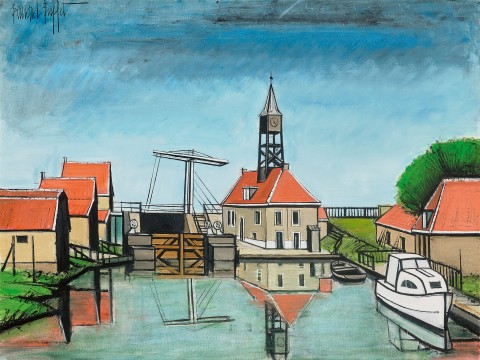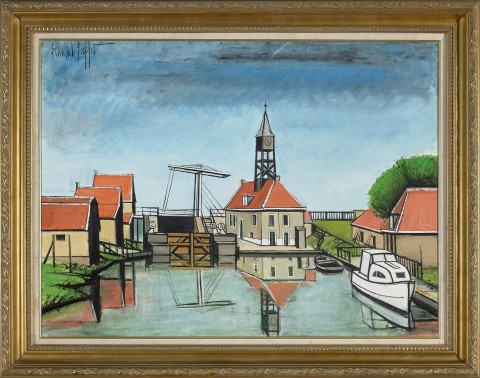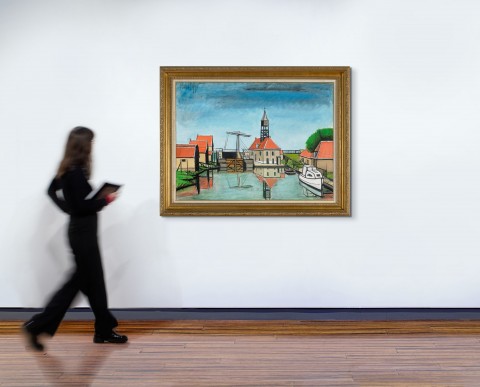HINDELOOPEN EN FRISE, 1985
BERNARD BUFFET
oil on canvas
98.0 x 130.0 cm
signed upper left: Bernard Buffet
inscribed with title verso: Hindeloopen / en Frise
Galerie Maurice Garnier, Paris (bears gallery stamp verso)
Private collection, Japan, acquired from the above in January 1989
Thence by descent
Private collection, Queensland
Hindeloopen, en frise, 1986, colour lithograph, 50.0 x 65.0 cm, edition of 150, published by Mourlot Editions, Paris
We are grateful to Galerie Maurice Garnier, Paris, for their assistance with this catalogue entry.
230527 Buffet in Studio NEW_cmyk.jpg
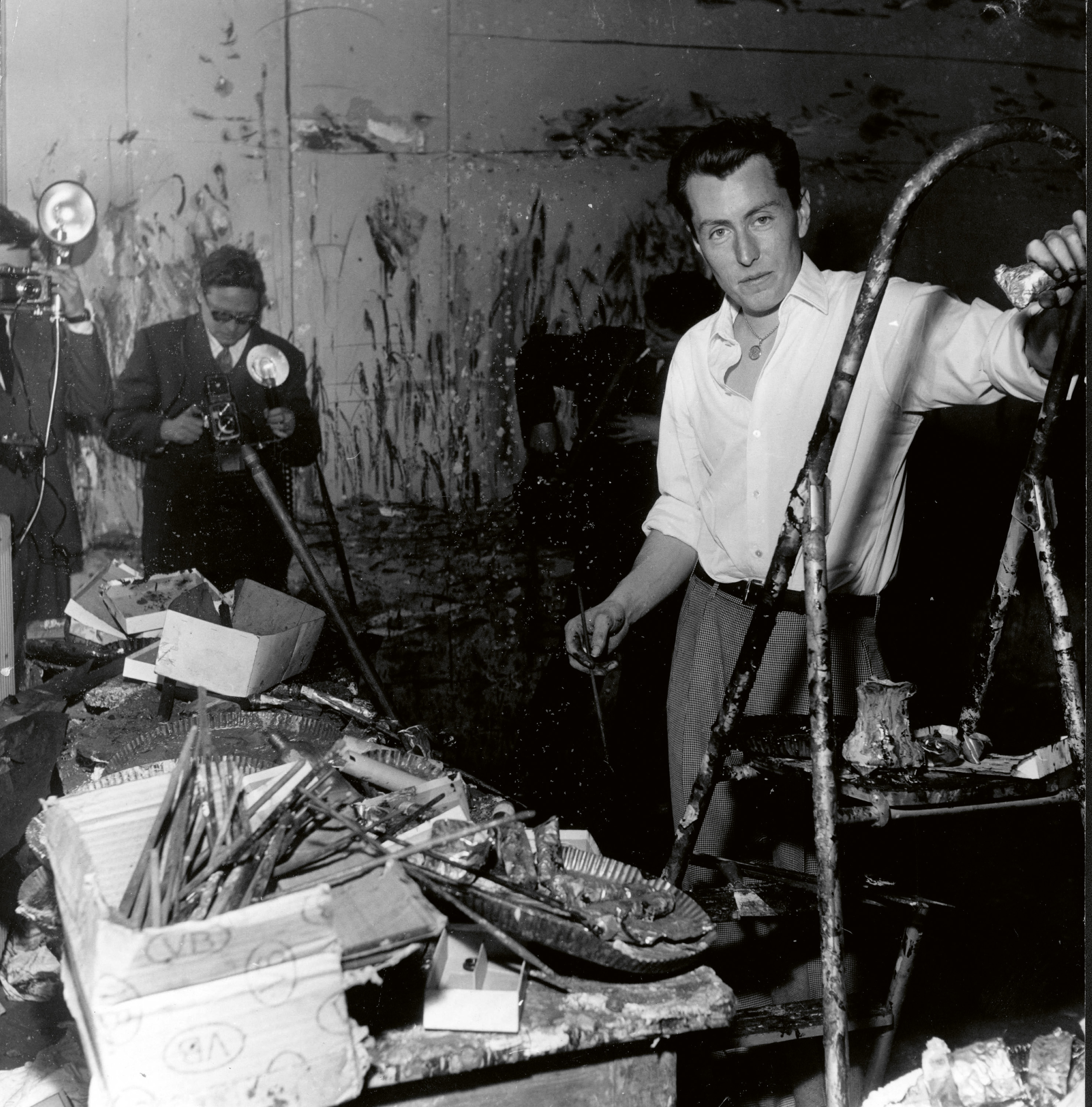
Bernard Buffet, once hailed as France’s finest post-war painter1, and reaching dizzying heights of fame and fortune before his thirtieth birthday, suffered from institutional and critical denigration in his home country throughout the second half of the 20th century. Only now, some thirty years after his death, is his abundant oeuvre and its influence on the course of modern art being reevaluated. Growing up in occupied France and coming of age during the material privations and societal malaise that followed World War Two, Buffet’s acclaimed early works were infused with Gallic spleen2, sapped of colour and spatial depth. In stark contrast to these spiky, grey and anguished paintings, Buffet’s picturesque landscapes of the 1970s and 1980s, including Hindeloopen, en Frise, c.1985 present with a flat graphic frankness an optimistic and sentimental view of the Western world.
A member of the L’Homme Témoin (Man as Witness) group supporting expressive social realism as opposed to modern abstraction, Buffet emphasised the everyday nature of his subject matter, insisting ‘realist painting for me is concreteness… the representation of things.’3 Buffet painted by lamplight only the scenes that he had seen with his own eyes, from poignantly desolate grey Parisian cityscapes in the 40s through to the brightly coloured, postcard views of landmarks from expensive holidays later in life. Buffet’s landscapes were often likened to the Post Impressionist ‘Peinture Montmartroise’ of Maurice Utrillo, his heavily outlined naive cityscapes replicating views from mass-produced postcards.4
From 1952, Buffet enjoyed the artistic freedom of producing yearly thematic suites of paintings at his representative gallery in Paris, Galerie Maurice Garnier, with subject matter ranging from the allegorical and historical (Passions of the Christ, 1952 and Joan of Arc, 1958) to more broadly appealing subject matter (Snowy Landscapes, 1976, and Flowers, 1979) and many based on the artist’s recent holiday destinations, both near and far: Churches of France, 1969, and Peking, 1996. Closely related to works in Buffet’s 1986 solo exhibition at Galerie Maurice Garnier, descriptively titled Les Pays-Bas (The Netherlands), Hindeloopen, en Frise, presents with detached rigour a large, crisp and famous view of the manual lock and drawbridge of the medieval town of Hindeloopen, in Friesland in the north of the Netherlands. Other paintings from the Pays-Bas suite included kitsch, timeless and emblematic scenes of windmills and friezes of canal houses and bridges in Amsterdam.5
A recurring subject in Buffet’s landscape paintings, the canal and its sluice gate provided a linear architectural structure suiting the artist’s strong graphic and linear style, doubled in mirrored reflections on the water in the foreground. Closely related to a colour lithograph produced by Mourlot Editions in an edition of 150 in 1986, this view of the small town celebrates the enduring triumph of man over nature and the ingenuity of Dutch engineering. Painted from the vantage point of a swing bridge over the Zijlroede canal, the single focal point of Buffet’s strict linear perspective is the sluishuis, the historical landmark of the lockkeeper’s house built in 1619 and an important strategic building in this longstanding trading port. Strangely devoid of people, Buffet’s landscape is stilled and muted, painted with a restricted and unmodulated colour palette of the terracotta red of tiled roofs, bright green lawns and a sky tinged with grey.
Buffet Image 2_cmyk.jpg
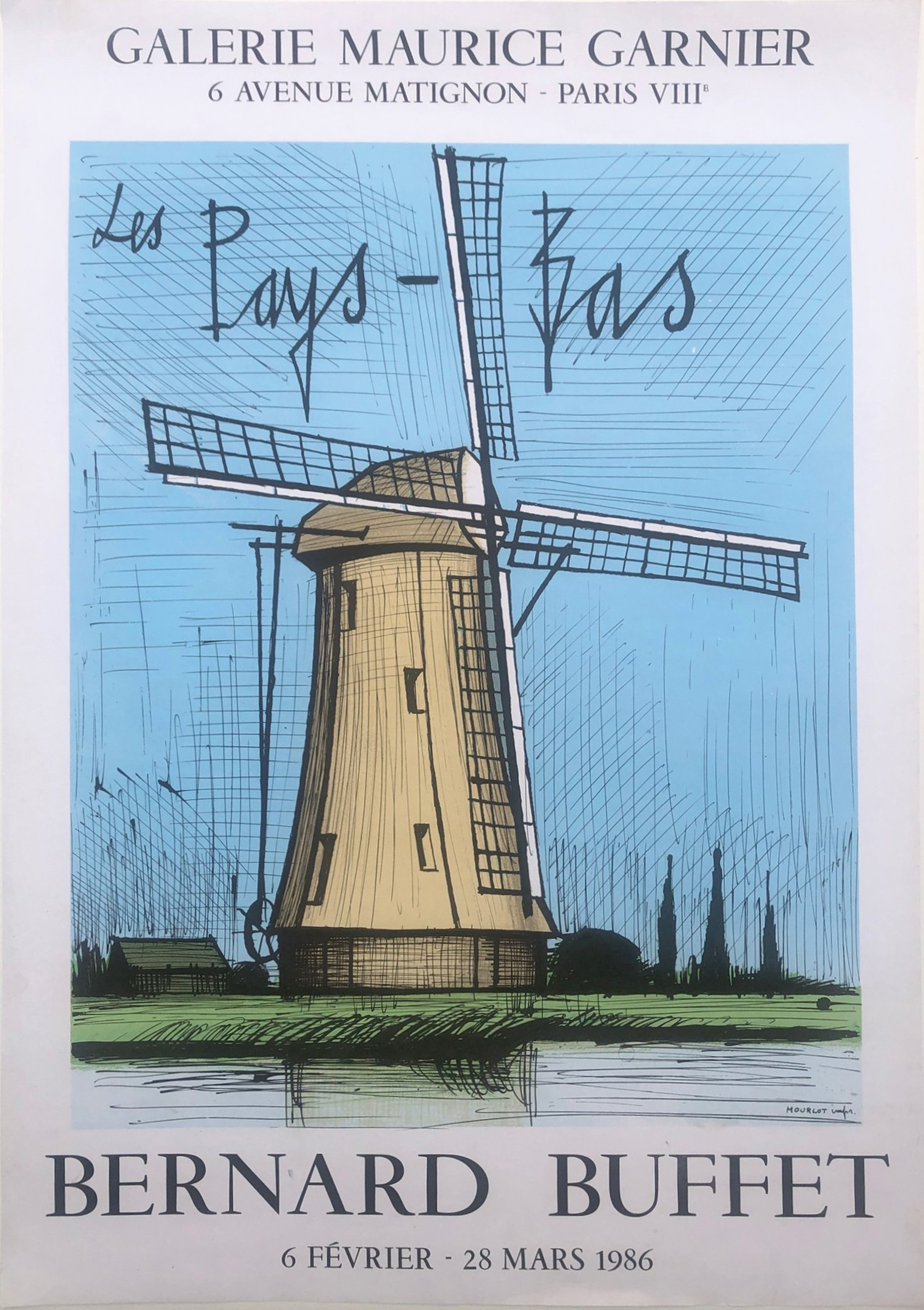
Hindeloopen, en Frise, painted with Buffet’s characteristic black outlines, with exacting geometry set out like an empty stage set, acknowledges the enduring historical value of European landmarks, still standing and in continuous use despite the material destruction of world wars and a rapidly changing contemporary landscape. Only the bright white canal boat moored to the right of the composition remains as an indicator of the modernity of Buffet’s view of this quaint town.
Wealthy Japanese businessman Kiichiro Okano was instrumental in fostering the widespread popularity of Bernard Buffet in Asia, building and dedicating a museum to the artist in 1973 in Shizuoka Prefecture, Japan, where it has housed the largest private collection of the artist’s work outside of France. The painting Hindeloopen, en Frise, never before seen at auction, has remained the same Japanese private collection since its purchase from Galerie Maurice Garnier in 1989.
1. Connaissance des Arts, Paris, No. 36, 15th February 1955
2. Coined by writer Charles Baudelaire, “spleen” describes a French feeling of melancholy and existential ennui.
3. Charbonnier, G., Le Monologue du peintre, Julliard, Paris, 1959, reprinted 2002, pp. 213 – 14
4. ‘Parcours de l’exposition’, dossier de Presse, Bernard Buffet Rétrospective, Musée d’Art Moderne de la Ville de Paris, 2016, p. 10
5. ibid.
LUCIE REEVES-SMITH
